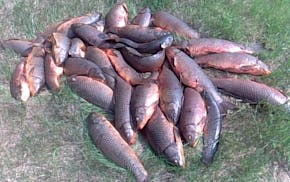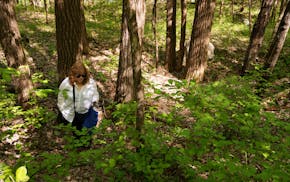Cathy Mackiewicz's dog was pulling harder than usual, its nose pointed toward a natural pit containing 15 green fish on the side of the road, about a quarter mile away from Bone Lake in Scandia.
She saw puncture wounds in several of the carp, some of which were the size of her 10-pound Jack Russell terrier. The smell emitting from the pit was horrid, she recalled.
"I was so surprised to see a big pile of fish," she said. "It smelled like something was rotting. It was gross."
Around the state, rotting piles of carp have been reported on social media and to the Minnesota Department of Natural Resources (DNR) over the last few months. Todd VanderWeyst, DNR conservation officer for the Paynesville area, estimates he received about a dozen calls for fish dumping this spring.
"There's one spot in particular where the landowner has had enough," he said. "[The fishers] shoot the fish and pull them up on shore and leave it there ... it's so nasty down there, the shoreline is literally crawling with maggots and it stinks."
The culprits killing the fish and leaving them in piles are likely irresponsible bow fishers, VanderWeyst said.
Bowfishing season starts in the spring, when vegetation around lakes is low and carp are in shallow waters, VanderWeyst said. Most of the fish in the piles are common carp, he said. The invasive species of fish were intentionally introduced as game fish in the 1880s, according to the DNR's website.
Common carp are one of the most damaging aquatic invasive species, diminishing water quality and the number of aquatic plants consumed by waterfowl and other fish, according to the University of Minnesota.
So, they are exempt from a state law that prohibits wasting any usable part of a protected wild animal.
But leaving their dead bodies to rot attracts scavengers and becomes a nuisance, VanderWeyst said. Doing so is a misdemeanor and, along with littering penalties, can carry fines topping $150.
Anglers catching other invasive carp species — silver, bighead, grass and black — need to report their catches to the DNR. Anglers who want to transport, possess or dispose of those species must obtain a special permit or speak to a DNR biologist.
Common carp don't need to be reported because they are relatively widespread and established in the state compared to the other types of invasive carp, DNR spokesman Joe Albert said.
Police in Wyoming, Minn., about 40 miles north of the Twin Cities, took to social media to describe the odor emitting from two piles of carp as "a stench so strong it might qualify as a biological weapon."
A pile near the Comfort Lake boat landing contained three fish and another by a roadway had about a dozen carp carcasses, according to Neil Bauer, Wyoming police chief.
"We did get some complaints from neighbors on the odor," he said. "It's an unpleasant experience for everyone trying to use the landing."
Catching carp-dumping culprits is difficult, VanderWeyst said.
Since 2021, the DNR has only issued two citations for returning rough fish taken by spearing, harpooning or archery to the water or for leaving rough fish on the banks, according to data from the department. Six verbal warnings were issued between 2021-23 and none were issued in 2024 or 2025.
"It's really tough, it's one of those things you have to be at the right spot at the right time. You have to surveil the area," VanderWeyst said. "You don't always see the license plates like what you see on [reality] television."
Whenever Justin Klages sees a pile of fish left to rot by a lake, he makes sure to clean it up.
Klages, president of the Land of Lakes Bowfishing Association, said he estimates a small number of bowfishers are leaving fish behind, but that small group gives responsible bowfishers a bad reputation.
"We tell people before you go out, you need a proper way to dispose of them," Klages said. "I try to educate homeowners on the lakes. Just because you have one or two bad apples, it's not a representation of the whole sport."
All it takes to dispose of carp properly is a little planning, he said.
Klages takes the carp he catches to farmers who feed it to their pigs. Other farmers will accept carp to fertilize soil. In the metro, places like the University of Minnesota's Raptor Center in St. Paul accept fish to feed the birds.
"It's us policing our own sport because we know the negative impacts it has when people leave a pile of fish at a landing," Klages said. "We don't want our sport to be taken away from us."

Why are stinky piles of rotting carp dotting lakeshores around Minnesota?
Where to find Minnesota's elusive state flower, the showy lady's slipper

Twin Cities musician Jeremy Messersmith finds music in the rhythm of hikes
Canoe, kayak and paddleboard: Your ultimate guide to paddling in the Twin Cities

